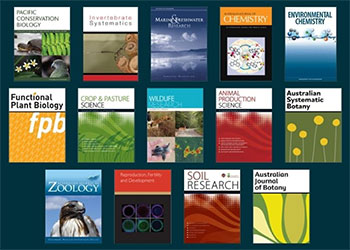
This year marks the 75th Anniversary of the Australian Journals of Scientific Research (AJSR) which represent a remarkable archive of more than 70,000 articles.
CSIRO Publishing and the Australian Academy of Science celebrated the anniversary at a gathering at Ian Potter House in Canberra on Thursday 7 December.
The event marked the long-running collaboration between the Academy and CSIRO, which publishes 1,000 articles every year under 14 AJSR titles.
The growing archive reflects Australia’s rich history of science as well as Australian scientists’ continuing impact on international research. Communicating the outcomes of that science in journals creates building blocks for future learning and understanding.
Development of science journals started to gain momentum early in the 20th century, but was halted by World War II. There was a shortage of resources, and printing equipment needed to be prioritised for government requirements.
Much of the research that might have been published in peacetime was also paused for security reasons, so by the mid-1940s there was a considerable backlog of work waiting to be published and not enough journals or local publishing capability.
In 1946, the CSIR (now CSIRO) proposed the establishment of an Australian Journal of Scientific Research—Series A, Physical Sciences and Series B, Biological Sciences—to capture the best of Australian research findings.
In 1948, Dr N.S. Noble from the Linnaean Society of New South Wales was appointed as editor and published the first volumes of the Australian Journal of Scientific Research. An editorial board was developed, and submissions were refereed by a broad range of specialists.
Through the following years the rules of conduct for the journals were established in collaboration with the Australian National Research Council (precursor to the Australian Academy of Science).
Demand for publishing services continued to grow and in 1950 three new journals were started: the Australian Journal of Agricultural Research, the Australia Journal of Applied Science, and the Australian Journal of Marine and Freshwater Research.
The expanding suite of journals became known as the Australian Journals of Scientific Research (AJSR) governed jointly by CSIRO and the Australian Academy of Science through the Board of Standards. By 1988 the AJSR comprised 11 titles.
During the late 1980s and early 1990s, the winds of economic rationalism buffeted the journals. CSIRO directed its publishing operation, including the journals, to adopt a commercially sustainable business model, so CSIRO funds might be targeted at directly supporting research. CSIRO Publishing was created, and the business unit took on the task of adapting to a new publishing channel: the internet.
All AJSR titles were available online by the end of 1997, making them more easily discoverable and speeding up the publication processes.
Digital journals quickly led to the idea of making articles available online for free, or ‘open access’. The scholarly and publishing communities wrestled with the open access concept for the first two decades of the 21st century, trialling various business models that would allow for free distribution of the articles, but which would also sustain the work of editors, publishers, and journal brands.

Today the number of journals in this collaboration sits at 14 and they publish more than 1,000 articles per year. Given the collaborative nature of science, many articles are now co-authored by researchers around the world.
All volumes are now digitised, accessible online and owned by the Australian public through CSIRO. This content will continue to contribute significantly to the landscape of trusted literature that informs decision-making and future research.
In 2023, as we reflect on the enormous changes in knowledge transfer, the significance of trusted research that has been peer-reviewed and published following ethical processes is greater than ever.
In the most recent agreement between the Academy and CSIRO, the focus is on moving towards open science and ensuring the integrity of the journals in an increasingly complex environment.
Many challenges face the editorial boards, reviewers, and publishing teams that support our journals. However, these dedicated teams value the role they play facilitating the application of research and collaborating to publish outcomes that will help solve societies biggest challenges.
© 2025 Australian Academy of Science